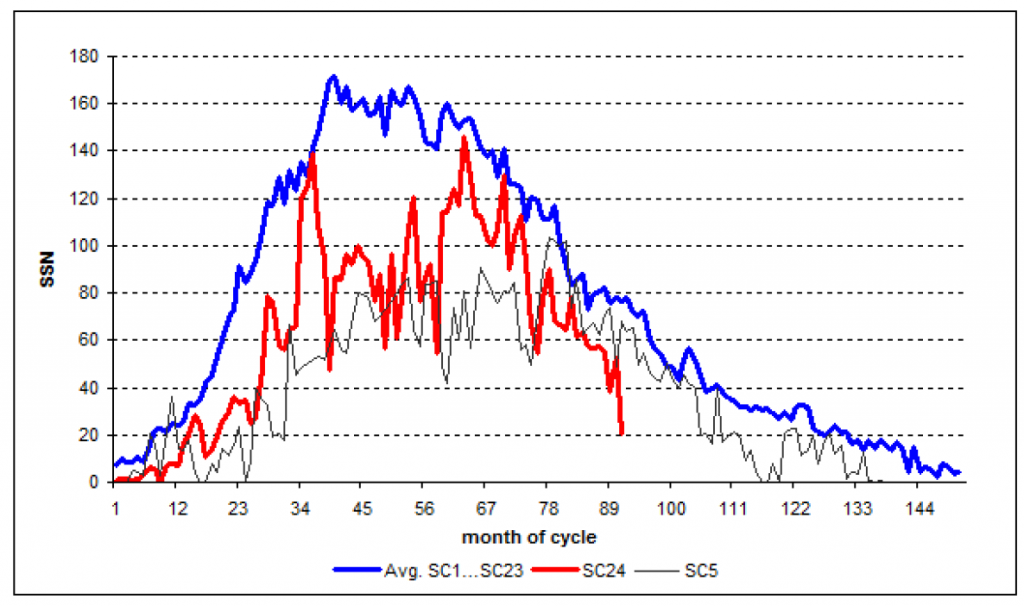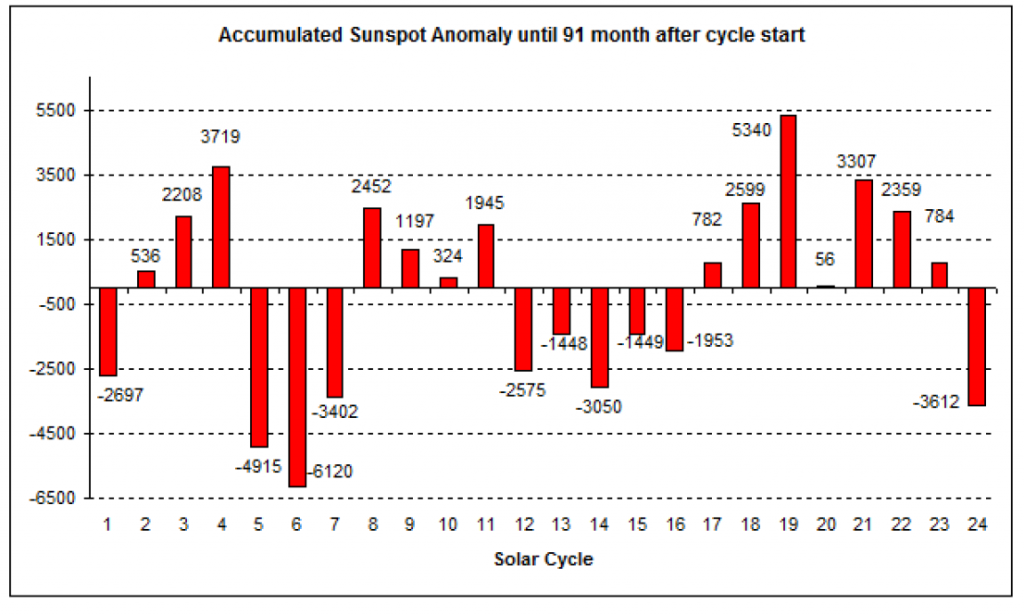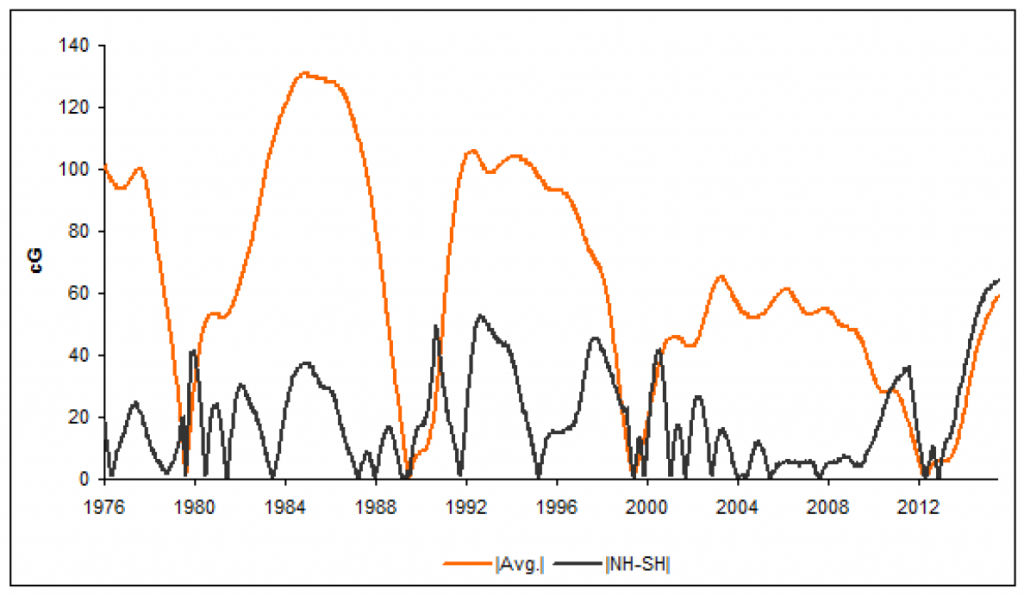The sun in May and June 2016
By Frank Bosse and Fritz Vahrenholt
(Translated/edited by P Gosselin)
Our sun in May was normally active for the cycle. The mean sunspot number (SSN) was 52.1, which was 2/3 of the mean value for month number 90 into the cycle. The mean is calculated from the previously observed 23 solar cycles occurring since March 1755.
The sun quieted down immensely in June with a mean SSN of only 20.9. This means solar activity in June was only 27% of the mean solar activity observed for month no. 91 in all previous cycles. For the month it was a record, as never has month no. 91 of all the previous cycles been so low in activity. The old record low for month 91 was much more (SSN=39), occurring in Cycle No. 14, from 1902 to 1914.
In June 2016 a total of 9 days saw a single sunspot. This resulted in an impressive plunge in the chart:

Figure 1: Solar activity in the current Cycle No. 24 (red) compared to the mean of the previous 23 solar cycles (blue) and the similarly behaving Cycle 5 (black).
The following chart shows the deviation from the mean for the accumulated number of sunspots for each solar cycle, 91 months into each respective cycle:

Figure 2: Deviation from the mean value (shown by blue curve in Figure 1), for the accumulated number of sunspots up to month 91 for each cycle. Cycle 19 was the most active while Cycle 6 was the least active – 91 months into the cycle.
The current Cycle 24 is less active than Cycle 5 and 6 of the Dalton Minimum, which occurred from 1790 to 1830.
What can we expect in the future? We reported awhile back on the solar polar field and promised to keep you posted on the latest news. What follows is a chart depicting the data up to June 2016:

Figure 3: The smoothed mean value of the solar polar field (orange) and the difference amount between the poles (black) in Centi Gauss (cG).
Here we see that the mean value of the polar field is as high as the minimum of Cycle 23. Using the current reliable level of knowledge, this may be pointing that the coming Cycle 25 will be as strong as Cycle 24 in terms of sunspot activity.
However the difference in the polar field at 64 cG is at the highest level since recording began in May, 1976.
Looking closely at the black curve compared to the orange one in Figure 3, we note the following characteristic: Since the start of observation, never has the difference between polar solar field been above the mean for so long. Using a very precise time resolution (in the original data with 10-day intervals) we are able to see that the duration of this phenomenon in Cycle 24 so far is more than 3 times higher than anything registered in Cycles 21 – 23.
Could such a magnitude and long ongoing difference in the polar field have an impact on the future of solar activity? Could it be a sign showing that the “solar dynamo”, which is responsible for sunspot activity, has gone out of step? Time will tell.





O/T: German Government demands meat consumption reduction to 300 to 600 gram per week to protect Earth from Global Warming, from a current 1100 gram.
http://www.welt.de/wirtschaft/article156928198/Deutschland-produziert-122-Prozent-zu-viel-Fleisch.html
I am very happy to be able to bring you this complete hilarity without having to report anything but what they actually said.
Also, whoever voted SPD-CDU into power: What’s wrong with your brain.
Greens say German meat production leads to destruction of the Amazon rain forest. In the same article.
Again, a big thank you to the Bundestag for the daily comedy.
“Also, whoever voted SPD-CDU into power: What’s wrong with your brain.” – DirkH
Maybe they weren’t eating sufficient meat? I wouldn’t be surprised.
After failing to use algae for fuel production, German algae researchers install algae cultivation tubes on institute facade, plan to use 1 kg daily of harvested algae to make algae smoothies.
Again, I did not have to invent any of this. Photos:
http://www.n-tv.de/wissen/Algen-wachsen-an-Berliner-Hausfassade-article18121526.html
Algae smoothies will help us greatly to reduce our meat consumption to the ration demanded by the German government I am sure.
Also, the country is a joke.
Dirk H
Germany has not captured the market on stupid, not yet. There is a long queue of stupid around the world. Take heart that the people still have the courage to stick it to them when it matters
Hi Pierre
I like you NTZ Blog and your critical viewpoint at wrong science, and therefore I don’t understand, why you are ignoring my well-meant hint from yesterday. The translation above has really two mistakes which you should correct:
1)”In June 2016 a total of 9 days saw NOT a single sunspot.”
2)”The current Cycle 24 is less active than CYCLE 7 of the Dalton Minimum, which occurred from 1790 to 1830.” (Lüning and Vahrenholt wrote actually: only cycle 5 and 6 were less active than 24…)
Best regards, GT
If you count the number of days on average during a 6-rotation period (184 days) where the sun was NOT spotless, you end up with an average length of such of approx. 1840 days (last 3 cycles including cycle 24). The real starting of spotless days for the ongoing cycle is more or less on normal or only 1 rotation before average.
Though we have had, officially 16 days without sunspots this year 2016, it is quite a fast start sun being spotless, and on many consecutive days, but this is not unnormal. The sun will still produce some significant activity now and then in the next couple years.
The sun will still have to wait for its minima at the earliest in May 2019, maybe as late as October same year.
CV-Helios Network – 11 Jul 2016
Overall current cycle is much weaker than normal.
I prefer this website to others, for the reasons he gives there:
http://www.landscheidt.info/?q=node/50
As per his counting, the first 8 days of July were “spotless” and the last two were very weak.
[…] Solar Cycle 24 Turns Unusual… Solar Polar Field Difference At Highest Leverl Since 1976 […]
[…] Solar Cycle 24 Turns Unusual… Solar Polar Field Difference At Highest Level Since 1976 […]